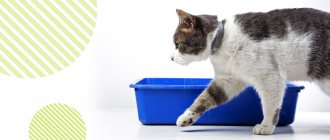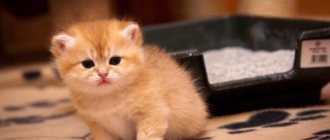Toilet training is one of the basic skills a kitten must learn. To prevent unpleasant cat “surprises” from ruining things and your mood, your pet must be trained to use the litter box. This is not so difficult to do, and our recommendations will help with this.
A conscientious breeder makes sure that the kitten gets used to the litter box before being handed over to the new owner. In addition, the mother cat teaches the babies, showing them what to do. In this case, the primary skill has already been acquired, and all that remains is to help the pet get used to the new place. Ask the breeder what device and filler your kitten is used to. If this is not possible or the animal has not yet mastered the toilet, training will have to start from scratch.
How to choose the right tray
It is important to properly equip your cat's litter box: an unsuccessful tray or litter will ruin all your efforts.
Choose a quality product made from durable plastic: cheap ones absorb odors and are difficult to clean well. A squeamish cat will refuse to go to the litter box if it does not seem clean enough to her. In addition, the smell of cheap plastic, even indistinguishable to humans, can be unpleasant to animals. Reliability also leaves much to be desired: if the container breaks quickly, you will have to get used to a new one.
Make sure the device is comfortable to use. The height of the sides does not interfere with entry and exit, and the width is sufficient for the animal to fit in the tray. It is best for a kitten to use a litter tray for growing up, including to avoid the need to retrain it.
Is it possible to train a baby to use the toilet of another cat?
Smell is the main safety criterion for cats. The kitten will not use someone else's potty. In this case, even neutral flavors will not help accustom the cat to the litter box.
In order for the baby to learn to use a device that has already been used, the tray must be disinfected and make sure that foreign odors have disappeared.
What types of tray designs are there?
Manufacturers offer several design options for cat litter:
- An open tray without a mesh
is a container into which filler is poured. It does not require daily cleaning and is completely safe. The disadvantage of such models is direct contact with the filler: it is advisable to choose one that will not stick to the paws and fur, otherwise the pet will spread the granules throughout the apartment. In addition, cats sometimes taste the litter: it is important to make sure it is safe. - Open with a mesh
eliminates contact with the filler: it is securely closed with a plastic grid. The paws will remain dry: all moisture will quickly drain down. But solid excrement gets on the mesh, so it will have to be washed daily. There is one more nuance - cats are accustomed to burying traces of vital activity, and with such a tray they are deprived of the opportunity to rustle with the litter. Not all animals like the grate: their claws cling to it when “burrowing” and cause discomfort. - The tray-house
differs from others in the presence of a top cover. It provides privacy when going to the toilet, which shy and timid animals like. Models are sold with and without a mesh; if cleaning is necessary, the cover can be removed. There is a semi-open version of the house with removable high walls. - Self-cleaning models
remove waste without human intervention immediately after the pet leaves the tray. Budget ones use composting toilet filler, which will have to be changed or washed periodically. When this needs to be done, the sensor on the device body will tell you. Expensive models connect to communications and drain waste into the sewer themselves. Such a device costs significantly more than a regular tray, but it saves your effort and eliminates the spread of bacteria and unpleasant odors. The device is powered from the mains, so it is important to make sure that there are outlets in the room. When purchasing, pay attention to the absence of noise during operation: animals are sensitive to sounds and may be frightened by even slight motor noise. - By 5-6 months, many cats are able to master the toilet
. If you train your pet to use the human toilet, you won't have to worry about the litter box. First, make sure that the toilet model is safe for the kitten: it should be easy for him to get out if he accidentally falls into the water. For greater safety, you can purchase a special pad at the pet store. It can be easily removed from the toilet when a person visits the toilet and then installed back.
What are the options for fillers for trays?
The filler is an important component: it helps realize the burying instinct. It is best to choose fragrance-free options that do not make noise when digging. All this can repel or frighten the animal. The smaller the kitten, the smaller the granules are needed, otherwise they will be inconvenient to dig. A sufficient layer is 4-5 cm.
The stores offer a large selection of fillers:
- Clumping pulp or grain
It allows moisture to pass through quickly, quickly removing it from the surface. The paws will not get wet, and an unpleasant odor will not spread in the room. To remove waste, you do not need to completely change the filler - just throw away the lumps. Available in the form of granules of different sizes, it is convenient for kittens: the particles will “grow” with them. Safe for health if swallowed. Some brands use special additives that change color depending on the composition of the urine. They will tell owners when their pet’s health requires attention.
- Zeolite
Does not stick to paws and fur and is able to quickly absorb a lot of moisture. The smell is poorly retained - the cat may refuse to use the toilet if it is not cleaned sufficiently.
- Woody
Consists of compressed sawdust. It is safe, absorbs moisture well and does not damage the sewer system when flushed down the toilet. But when digging, light granules spill out over the sides and stick to the paws and fur.
- Silica gel
Effectively retains moisture and odor, does not stain the cat, looks aesthetically pleasing and does not require frequent cleaning. It is expensive, but is used economically. Suitable only for models with mesh: ingestion of granules leads to the development of gastrointestinal obstruction. The specific sound when burying can frighten the animal.
- Homemade
From sand, paper, sawdust or other available materials. It is economical, but requires careful daily cleaning, otherwise an unpleasant odor cannot be avoided. Not just any material will do: it is important to keep the sand clean, especially if it is intended for a small kitten. Do not use newsprint: printing ink contains harmful substances.
How to train a kitten to use a litter box
Toilet skills are fully developed by about 6 months. But this does not mean that until this age the pet will relieve itself wherever necessary. Accustoming should begin at the age of 1 month: by this time the baby already knows how to endure. Most kittens take a few days to a week to learn to use the litter box.
If your pet has already used a litter box from a breeder or another owner, choosing the same model and litter will speed up training. In any case, start by introducing yourself to the new device: let him calmly examine and smell it. Stay close, speak kindly to the animal, stroke it, play with it. It is important that the tray evokes positive emotions.
Cats go to the toilet shortly after eating. Wait 15-20 minutes and observe the behavior. As soon as the kitten begins to worry, scratch its paw, try to sit down - carefully pick it up and take it to the tray. Do not fuss or make noise so as not to frighten the animal. Rustle the filler, dig into it to tell you how to proceed next. It is useful to massage the tummy, imitating maternal licking.
It is more convenient to monitor your pet in order to take it to the toilet on time in a small space. Limit his movements around the house to one room in the first days. Make sure that the litter box is placed far away from food bowls and a bed: the cat never relieves itself where it eats and sleeps.
When the kitten understands what is required of him, start scolding him for mistakes. Speak in a stern voice, but do not shout. Under no circumstances hit the animal or poke its nose into a puddle. This way you will lose his trust and will not achieve the desired effect. Cats understand intonation very well: a reprimand is enough to express displeasure. If you didn’t notice the puddle in time, don’t scold the kitten: he won’t be able to connect your anger with the offense. Don't forget to reward correct behavior: praise, pet and treat him with treats. All this encourages you to fulfill your requirements.
Be careful when choosing a location for the toilet. It is important that the entrance to the room is not closed or blocked by furniture and other objects. It is advisable to have a washable floor covering: carpet and other absorbent materials will suffer from wet paws and develop an unpleasant odor. Cats do not like to be disturbed: make sure the device is located in a secluded location.
Remember that cats are territorial creatures. If there are several of them, each needs a separate tray.
Consider the age of the kitten:
- 1 month is the best time to start training. The kitten already has some experience: it has observed its mother’s behavior. Temporarily place the bowl, bed and tray in one room so that the baby has time to run to the toilet.
- At 1.5-2 months the animal remembers where it went last time. To avoid repeated attempts to relieve yourself in the wrong place, carefully wash away your traces. Don't use bleach; it increases the smell of cat urine. If the kitten persists in choosing a place, any citrus flavor will do. Or temporarily install a tray where you find a puddle. When your pet gets used to using it, move it. Be patient: your kitten is still very young and will need time to develop the skill.
- At 3-4 months, learning happens the fastest: the kitten has grown up, he is quite smart and easily learns new things. Just choose the appropriate container and follow our recommendations.
- 5-6 months is a suitable age for toilet training. To get the kitten used to the toilet being high, gradually raise the tray above the floor level. Any flat objects, for example, a stack of old newspapers, are suitable for this. Increase the height gradually: once every 1-2 weeks. When the tray reaches the surface of the toilet, place it on the closed lid. If your pet continues to use his potty successfully, place some litter with his scent in the bottom of the toilet. Pet stores sell special pads for ease of training.
Some useful tips:
- If your kitten ignores the litter box, make sure the container is large enough to accommodate the cat. Especially if the animal is large.
- Maybe he doesn't like the smell or the texture or size of the pellets - try offering other options.
- If you purchased a model with a mesh, observe the behavior at the moment of “burying”. Claws getting stuck in the mesh cells causes discomfort.
- Is your pet timid or shy? A more secluded room or tray-house will help solve the problem.
An unexpected refusal to use the toilet after toilet training is a reason to consult a veterinarian. A possible reason is health problems.
Why does the cat walk past the litter box?
There are times when a kitten or even an adult cat comes to the litter box, but goes to the toilet next to the litter box.
Main reasons:
- The kitten doesn't like the litter. It has an unpleasant odor, it can be either chemical or the smell of waste.
- If you don’t like the smell of the litter box itself, you may have washed it with a chemical or chlorine, which the kitten does not tolerate.
- The sides of the tray are too high and it is uncomfortable for the kitten to jump so high. The toilet must be accessible.
- Well, the kitten may simply be very young and not understand how to go to the toilet correctly. Continue training and over time his behavior will improve.
Eliminate the reasons, this should help. If not, contact your veterinarian; perhaps something is bothering the kitten.
How to litter train a stray kitten
A stray kitten can be trained just as well as a domestic one. In addition, the experience of a wandering life taught him independence and developed his intelligence. For litter box training, the same recommendations apply as for domestic kittens.
First of all, wash the animal and treat it for parasites. Before you start your training, make sure it is healthy and not stressed by being in an unfamiliar place. Give time to look around and get comfortable: for an outdoor kitten, your home is a source of many impressions. It is better to limit his stay to one room for a while and not rush to get to know other pets, if there are any. Make it clear right away: he is on your territory and must accept your rules.
Your new pet is used to relieving itself outside. Offer him a pot with a net or add a little sand to the filler. This will reduce the difference between the new and familiar toilet. Try a litter box: Outdoor cats tend to relieve themselves in privacy. Choose the most spacious open container: the kitten is not used to limited space. If the animal uses the potty only for minor needs, try placing a second one nearby.
Useful tips
To ensure that keeping an animal does not cause problems, you must follow a few simple rules.
- Clean the tray in a timely manner. It is better to do this as soon as the animal goes to the toilet. Cats are very clean, so if the litter box is dirty, they won't go in it a second time.
- Choose a suitable filler.
- Choose a tray that is suitable in size and wall height.
- The place where the cat litter is located should be quiet. The animal does not like to be disturbed, so if the tray is in a noisy place, it will choose another one.
- Do not place the tray next to indoor plants, as there is a possibility that the ground will be perceived as a convenient place for the toilet.
- Do not spray strong-smelling substances into the tray - perfume, etc. - the animal will stop going to this place.
How to train an adult or elderly cat to use a litter box
It is more difficult to train an adult animal: it has already acquired skills and habits. In addition, the kitten, like any child, is ready to learn new things. Adult cats focus more on their life experiences. To do the necessary things in safety, a street animal looks for a secluded place. Once in the apartment, it will try to use the space behind or under the furniture for this purpose. Do not punish for this: the pet does not yet know how to behave.
For the first time, it is better to place everything you need in one room and monitor the behavior. When trying to relieve itself, take the cat to the litter box and leave it alone, closing the door. Limit access to possible shelters that the animal can use for the toilet, and place the container in the most accessible place. To clue your cat in to its purpose, a napkin with the scent of its urine will do. To select a device, use our recommendations for homeless kittens.
If the cat lived in a shelter or with another owner, find out what kind of litter box and litter she used before. The more familiar the new toilet seems, the easier it is to get used to it. An adult or elderly animal will need more time to develop the necessary skill. Be patient, try to earn trust, praise and encourage correct behavior. This will help you adapt and learn faster.
Create ideal conditions
In order for the kitten to quickly get used to its new toilet, it is necessary to clean it thoroughly .
This should be done as often as possible. A dirty litter tray is unlikely to attract an animal. The kitten will look for a cleaner place. If you use clumping litter, the used composition should be removed with a spatula and thrown into a bag. It's better to tie it right away. In the first weeks, you can leave feces in the cat's litter box. This will speed up the addiction process.
All filler in the tray must be changed regularly . This should be done at least once a week. In this case, the cat litter box must be washed thoroughly. You should not use toxic detergents. It is enough to use a soap solution. The tray must be dried after cleaning and washing. Only after this can it be filled with fresh product.
If the kitten has gone past the litter box, then this area must be carefully treated to eliminate odors. Otherwise, the incident will repeat.
How to train a tray without filler
A good option for use without filler is a model with a grid. Moisture will flow down through the holes and will not wet your paws. Start training him to use a litter tray: this will speed up the process. Usually, reliable consolidation of a skill takes 3-4 weeks. When the kitten gets used to walking in place and stops making mistakes, it’s time to start weaning it off the litter. Try leaving the container empty and placing a napkin with the smell of your pet's urine in it: it will help you get your bearings. If the kitten does everything correctly, praise and reward him. If you refuse to use an empty tray, return the filler and reduce its amount gradually.
Not all cats get used to a litter box with bars. Without filler, it is possible to use a container without a mesh, but the cat's paws will be wet in it. Place an absorbent mat under the device: it will eliminate marks and odors in the apartment.
When choosing a tray without filler, be prepared to clean it immediately after use, otherwise an unpleasant odor cannot be avoided. Or get a self-cleaning toilet so you don't have to constantly clean it.
At what age does training begin?
The right recommendations will help speed up the long process. Kittens are also children, so there is no certain age for litter box training to be easy and quick. You can force an animal to go potty at 2 months or after 3 months - it depends on its intelligence and learning ability.
If a baby lives with a mother cat, he copies her behavior. The two-month-old kitten is already coping with the task on his own. If the mother is not nearby, the owner can train the cat to use the litter box.
It is not difficult to train a kitten to use the toilet in an apartment, especially when there is a cat nearby, even at 1 month, if the pet is smart. It’s not too late to do this even at 3 months.
Features of litter training cats of different breeds
Our recommendations are suitable for all kittens and adult cats, but some breeds have their own characteristics.
- The Scottish Fold or straight-eared cat is very intelligent and easy to train. But this does not mean that she will learn everything without your help. Many representatives of the breed like clay litter, but special preferences are possible.
- Canadian and British Sphynxes often prefer an open litter box. Make sure the filler does not produce dust or fine particles when digging. Sphynx cats are susceptible to respiratory diseases; it is advisable to minimize contact with dust. Finding themselves in an unusual environment, kittens try to hide - place the toilet close to the shelter. Some representatives of the breed urinate while standing and end up on the wall. Secure a piece of waterproof material in this place, hanging its edge into the tray. Or buy a tray house with an exit from the top. When training your kitten, be gentle and patient.
- For cats of large or particularly shy breeds, such as Maine Coon or Ragdoll, models with removable high sides or a roof are suitable.
Tray training tools
To speed up learning, there are special tools:
- Fillers simplify the task: with their help, the pet realizes the burying instinct.
- Sprays and drops contain substances whose odor reminds a kitten of the excrement of an adult animal. It is enough to put a piece of paper soaked in an attractive substance into the filler. This “mark” lets the kitten know that this place is suitable for the toilet. Sprays are also suitable for adult cats, reminding them of the smell of urine.
- Sometimes valerian drops, which are sold in pharmacies, are used for the same purpose.
The effectiveness of the products depends on the specific animal. If one doesn’t help, try something similar from a different brand.
Toilet training is an important skill that a domestic cat cannot do without. Patience, kindness and our recommendations will help you easily teach your pet to use the litter box.











